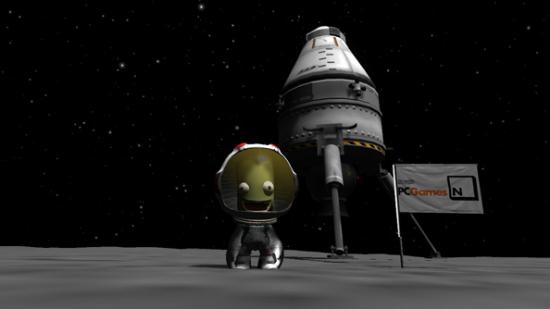While it’s touched down in alpha form, you can read our Kerbal Space Program review to see if it’s worth your buck.
Now that rocket-building spaceflight simulator Kerbal Space Program has added the ability to plant flags on the celestial bodies you visit, I am finally able to reconcile my two greatest passions: space exploration and the infinitely disheartening opinions of UKIP politician Roger Helmer MEP.
By adopting the man’s face as my flag and emblazoning his tweets on weather-proofed golden plaques, I shall populate the planets with his pithy postulations. Long after the scorched ashes of mankind have been scattered to the interstellar winds, the ruminations of Helmer will pervade, perhaps one day for alien civilisations to read, understand, and better themselves that they might not suffer our fate.
You can help too! Here’s a quick guide to delivering Roger’s message to our six nearest neighbours.
Mun
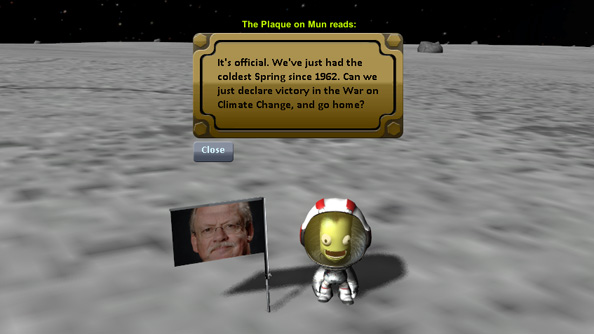
Mun is an analogue of our own moon, the ghostly space rock that inspired our first tentative steps into the stars. It’s the easiest of the planetary bodies to reach, floating just 11,400 kilometres above Kerbin (the game’s analogue of Earth). Mun lacks an atmosphere, and so requires careful use of thrusters to touch down. However, its low gravitational pull makes return voyages to Kerbin a simple enough endeavour. I put Roger’s tweet about climate change here.
Minmus
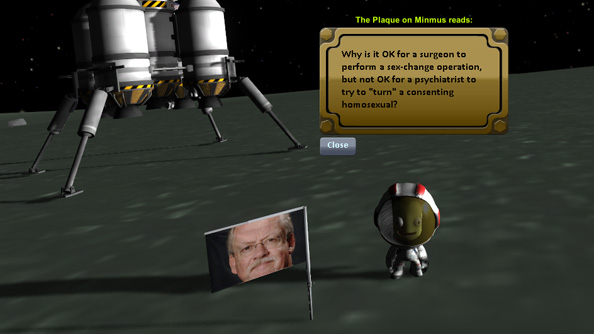
Minmus is the smaller of Kerbin’s two moons, orbiting farther out than Mun at 46,400 kilometres. The distance of this mini-satellite demands a greater delta-V than that required to hit Mun (delta-V being the capacity of your rocket to change its velocity), and so a larger or more efficient rocket is needed. However, it’s diminutive mass makes for a low gravitational pull, and so landing and returning to Kerbin is as straightforward as it gets. I put Roger’s tweet about gay conversion therapy here.
Duna
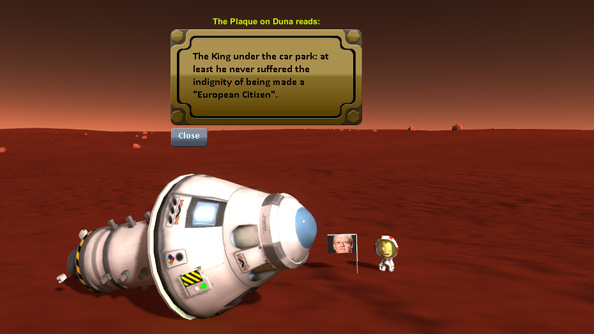
Duna is the game’s Mars analogue and the next planet out from the sun. It requires the least delta-V of any other planet to reach, and so is a milestone target for new players. Duna’s thin atmosphere facilitates a real-world technique known as aerobraking, in which a ship, rather than expend vital fuel to slow down and enter a stable orbit, will burn through a planet’s upper atmosphere and use that drag to naturally reduce its velocity. Here, I placed Roger’s tweet about the European Union.
Ike
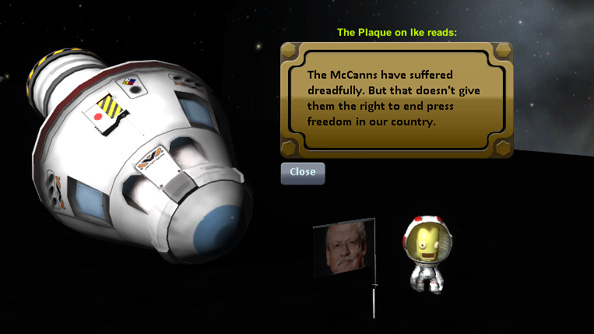
Ike is Duna’s only natural satellite, orbiting at a low altitude of just 3,000 kilometres. Twice as wide as Kerbin’s Minmus, this moon’s gravitational sphere of influence is relatively large, making for likely encounters when approaching Duna. Ike’s extremely mountainous surface makes landing difficult, though its lack of an atmosphere makes return journeys a possibility. Interplanetary round trips are a challenge for any player, usually requiring complex, multi-stage rocket designs. My own ship was found lacking, as you can see. On Ike, I left Roger’s treatise on freedom of the press.
Eve
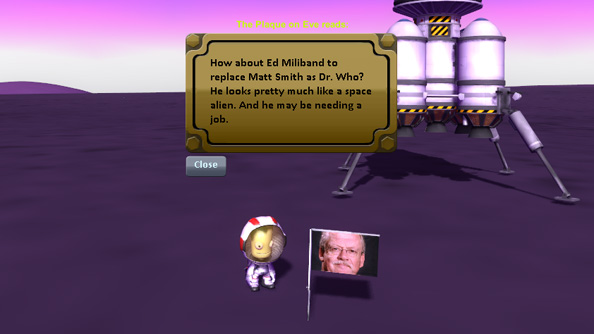
Eve’s pinkish hue takes some artistic license, as this is actually Kerbal Space Program’s version of the bum-beige Venus. Just like our real world neighbour, Eve has a noxiously thick atmosphere and high gravity, making landing difficult and taking off even more so. Thankfully, the dense air allows for the use of parachutes while landing. On the return, that same dense air will kill your fuel efficiency on ascent, so successful round trips to Eve require hefty fuel payloads. Also, do remember to attach a ladder to your lander during construction, this poor kerbonaut was stranded on Eve’s surface forever as his jetpack was too weedy to thrust him back up to my ship’s hatch. I left Roger’s opinion of Ed Milliband on the surface of Eve.
Gilly
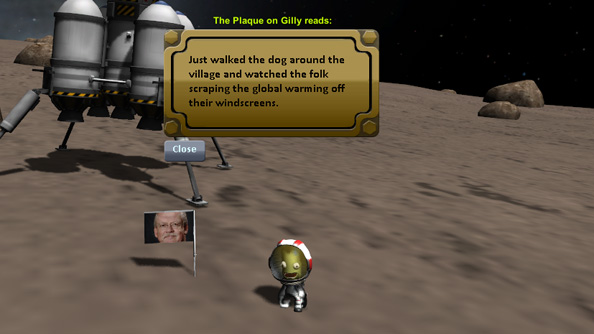
Gilly is pebble-like, the tiniest celestial body in the game and Eve’s only moon. Actually reaching Gilly is difficult however, due to the moon’s tiny sphere of influence and eccentric orbit. Catching it requires some careful course management in order to cross the moon’s path, and overshooting the thing is common. Gilly’s gravity is just 0.2% that of Kerbin, which is fun. A single jump takes your kerbonaut kilometres into the air, while escape velocity can be achieved using just a jetpack. Roger Helmer looks right at home here on the frontier of scientific discovery and unrelenting human progress. I leave Gilly with his joke about how global warming isn’t real.
Have you imported the faces of any right-wing politicians into your favourite game? Let us know in the comments below.
